全英初中英语教案
- 格式:doc
- 大小:56.50 KB
- 文档页数:17
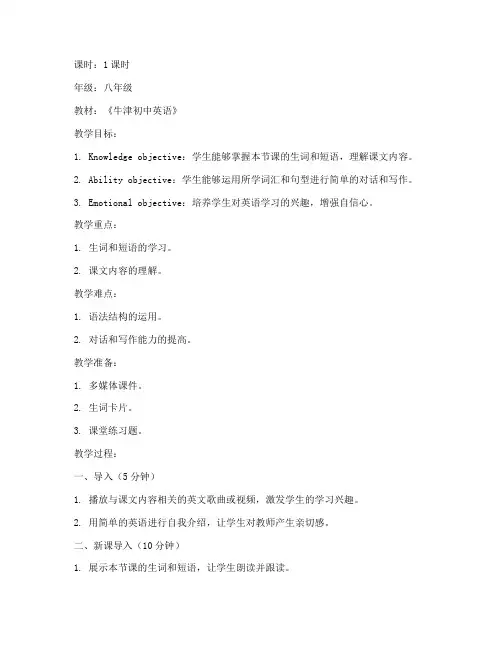
课时:1课时年级:八年级教材:《牛津初中英语》教学目标:1. Knowledge objective:学生能够掌握本节课的生词和短语,理解课文内容。
2. Ability objective:学生能够运用所学词汇和句型进行简单的对话和写作。
3. Emotional objective:培养学生对英语学习的兴趣,增强自信心。
教学重点:1. 生词和短语的学习。
2. 课文内容的理解。
教学难点:1. 语法结构的运用。
2. 对话和写作能力的提高。
教学准备:1. 多媒体课件。
2. 生词卡片。
3. 课堂练习题。
教学过程:一、导入(5分钟)1. 播放与课文内容相关的英文歌曲或视频,激发学生的学习兴趣。
2. 用简单的英语进行自我介绍,让学生对教师产生亲切感。
二、新课导入(10分钟)1. 展示本节课的生词和短语,让学生朗读并跟读。
2. 通过图片或实物展示,帮助学生理解生词和短语的意义。
3. 邀请学生举例说明生词和短语在句子中的用法。
三、课文学习(15分钟)1. 学生自读课文,理解课文内容。
2. 教师引导学生分析课文结构,讲解重点句型。
3. 邀请学生朗读课文,纠正发音和语调。
四、语法讲解(10分钟)1. 讲解本节课的语法知识点,如时态、语态等。
2. 通过例句和练习题,帮助学生掌握语法规则。
3. 学生进行语法练习,教师巡视指导。
五、对话练习(10分钟)1. 教师组织学生进行对话练习,巩固所学知识。
2. 学生分组进行角色扮演,提高口语表达能力。
3. 教师点评学生的对话,指出不足之处。
六、写作练习(10分钟)1. 学生根据所学内容,进行写作练习。
2. 教师提供写作指导,如句子结构、段落组织等。
3. 学生完成写作任务,教师批改并给予反馈。
七、课堂小结(5分钟)1. 教师总结本节课的学习内容,强调重点和难点。
2. 学生回顾所学知识,提出疑问。
3. 教师解答学生的疑问,巩固所学知识。
八、作业布置(5分钟)1. 学生完成课后练习题,巩固所学知识。
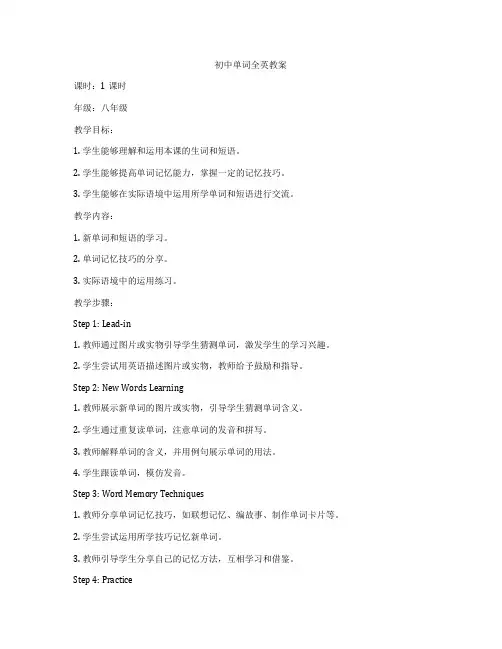
初中单词全英教案课时:1课时年级:八年级教学目标:1. 学生能够理解和运用本课的生词和短语。
2. 学生能够提高单词记忆能力,掌握一定的记忆技巧。
3. 学生能够在实际语境中运用所学单词和短语进行交流。
教学内容:1. 新单词和短语的学习。
2. 单词记忆技巧的分享。
3. 实际语境中的运用练习。
教学步骤:Step 1: Lead-in1. 教师通过图片或实物引导学生猜测单词,激发学生的学习兴趣。
2. 学生尝试用英语描述图片或实物,教师给予鼓励和指导。
Step 2: New Words Learning1. 教师展示新单词的图片或实物,引导学生猜测单词含义。
2. 学生通过重复读单词,注意单词的发音和拼写。
3. 教师解释单词的含义,并用例句展示单词的用法。
4. 学生跟读单词,模仿发音。
Step 3: Word Memory Techniques1. 教师分享单词记忆技巧,如联想记忆、编故事、制作单词卡片等。
2. 学生尝试运用所学技巧记忆新单词。
3. 教师引导学生分享自己的记忆方法,互相学习和借鉴。
Step 4: Practice1. 教师创设实际语境,如情景剧、角色扮演等,让学生运用所学单词和短语进行交流。
2. 学生分组进行练习,教师巡回指导。
3. 教师选取部分学生进行展示,给予评价和反馈。
Step 5: Consolidation1. 教师布置作业,要求学生运用所学单词和短语进行写作或口语表达。
2. 学生通过单词卡片、学习软件等途径进行复习和巩固。
教学评价:1. 课后收集学生的作业,评估学生对单词和短语的掌握情况。
2. 在下一节课开始时,进行单词复习测试,了解学生对单词的记忆情况。
3. 观察学生在课堂上的参与度和实际运用能力,给予评价和反馈。
教学反思:本节课通过全英教学,帮助学生学习和掌握新单词。
在教学过程中,要注意以下几点:1. 注重学生的参与度,鼓励学生积极开口说英语。
2. 给予学生足够的练习机会,提高学生的实际运用能力。
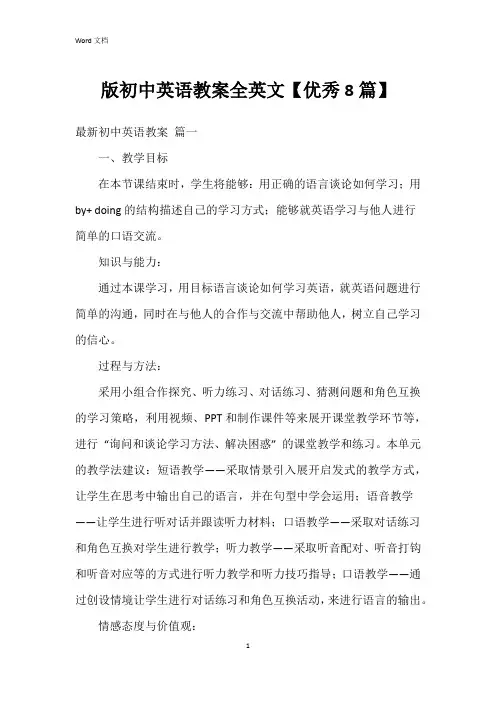
版初中英语教案全英文【优秀8篇】最新初中英语教案篇一一、教学目标在本节课结束时,学生将能够:用正确的语言谈论如何学习;用by+ doing的结构描述自己的学习方式;能够就英语学习与他人进行简单的口语交流。
知识与能力:通过本课学习,用目标语言谈论如何学习英语,就英语问题进行简单的沟通,同时在与他人的合作与交流中帮助他人,树立自己学习的信心。
过程与方法:采用小组合作探究、听力练习、对话练习、猜测问题和角色互换的学习策略,利用视频、PPT和制作课件等来展开课堂教学环节等,进行“询问和谈论学习方法、解决困惑” 的课堂教学和练习。
本单元的教学法建议:短语教学——采取情景引入展开启发式的教学方式,让学生在思考中输出自己的语言,并在句型中学会运用;语音教学——让学生进行听对话并跟读听力材料;口语教学——采取对话练习和角色互换对学生进行教学;听力教学——采取听音配对、听音打钩和听音对应等的方式进行听力教学和听力技巧指导;口语教学——通过创设情境让学生进行对话练习和角色互换活动,来进行语言的输出。
情感态度与价值观:通过参与课题教学活动,增进同学之间的了解和友情,并在交流中了解英语学习的方法,建立学习英语的自信。
二、教学重难点教学重点:学习并掌握How do you study...? I study...by ....等相关句型和词汇。
学习并掌握用by + doing 结构表达方式方法。
教学难点:学习并用丰富的语言描述英语学习的方式和方法。
三、教学策略短语教学——采取视频引入话题然后进行启发式教学,并在对话中运用;语音教学——让学生跟读听力材料进行模仿式操练;口语教学——采取pair work 和Role- play问答式的口语交际活动或小组活动互相操练;听力教学——采取采取听音配对、听音打钩和听音对应等方式语法教学——通过模仿听力材料进行对话练习,在教师的纠正中培养正确的by + doing 的结构意识。
初中英语公开课教案篇二课前准备教师:准备游戏时所用的图片(食物、蔬菜、动物)。
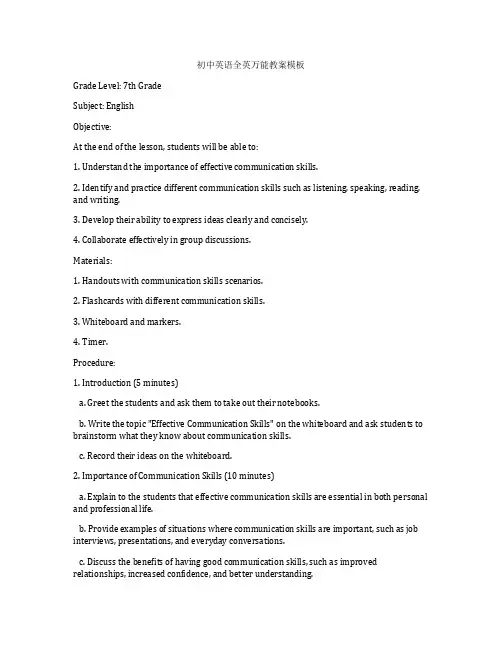
初中英语全英万能教案模板Grade Level: 7th GradeSubject: EnglishObjective:At the end of the lesson, students will be able to:1. Understand the importance of effective communication skills.2. Identify and practice different communication skills such as listening, speaking, reading, and writing.3. Develop their ability to express ideas clearly and concisely.4. Collaborate effectively in group discussions.Materials:1. Handouts with communication skills scenarios.2. Flashcards with different communication skills.3. Whiteboard and markers.4. Timer.Procedure:1. Introduction (5 minutes)a. Greet the students and ask them to take out their notebooks.b. Write the topic "Effective Communication Skills" on the whiteboard and ask students to brainstorm what they know about communication skills.c. Record their ideas on the whiteboard.2. Importance of Communication Skills (10 minutes)a. Explain to the students that effective communication skills are essential in both personal and professional life.b. Provide examples of situations where communication skills are important, such as job interviews, presentations, and everyday conversations.c. Discuss the benefits of having good communication skills, such as improved relationships, increased confidence, and better understanding.3. Identifying Communication Skills (10 minutes)a. Hand out the flashcards with different communication skills (e.g., listening, speaking, reading, writing) to the students.b. Ask students to work in pairs and practice identifying the different communication skills mentioned in the scenarios.c. Encourage students to ask questions and clarify their understanding.4. Group Discussions (15 minutes)a. Divide the class into small groups of 3-4 students.b. Hand out the handouts with communication skills scenarios to each group.c. Instruct each group to practice the scenarios and discuss the communication skills required in each situation.d. Encourage students to take turns speaking and listening.5. Role-Plays (10 minutes)a. Ask each group to choose one scenario from their handouts and perform a role-play in front of the class.b. Provide each group with a timer and instruct them to complete the role-play within 2 minutes.c. Encourage students to focus on using clear and concise language, maintaining eye contact, and using appropriate body language.6. Feedback and Reflection (5 minutes)a. Provide feedback to each group, highlighting their strengths and areas for improvement.b. Ask students to reflect on their own communication skills and identify areas they want to work on.c. Encourage students to practice their communication skills both in and outside of the classroom.7. Closure (5 minutes)a. Summarize the importance of effective communication skills.b. Remind students to continue practicing their communication skills in all aspects of their lives.c. Thank the students for their participation and dismiss the class.Assessment:1.观察学生在角色扮演中的表现,评估他们的听说能力以及沟通技巧的运用。

英语初中全英教案Level: Junior High SchoolObjective:At the end of the lesson, students will be able to:1. Listen and understand discussions on climate change.2. Speak confidently about the causes, effects, and solutions to climate change.3. Participate effectively in a group debate on climate change.Materials:1. Handout on climate change facts2. Debate topics and guidelines3. Recording devices4. Whiteboard and markersLesson Plan:Introduction (5 minutes)1. Greet students and ask them to briefly introduce themselves.2. Lead a warm-up discussion on environmental issues, asking students what they know about climate change.3. Hand out the climate change facts handout and explain that they will be using this information to prepare for a group debate.Listening Activity (15 minutes)1. Play a recording of a climate change debate.2. Ask students to take notes on the causes, effects, and solutions mentioned in the debate.3. After the recording, lead a class discussion, asking students to share their notes and ask any questions they may have.Speaking Activity (15 minutes)1. Divide students into groups of three or four.2. Hand out the debate topics and guidelines, explaining that each group will be assigned a topic and will have to prepare a speech supporting their viewpoint.3. Give students 10 minutes to prepare their speeches, encouraging them to use the climate change facts handout as a reference.4. Conduct the group debate, allowing each group to present their speech and engage in a question-and-answer session with the class.Closing (5 minutes)1. Ask students to reflect on what they learned from the debate and share their thoughts on the importance of taking action against climate change.2. Encourage students to continue discussing and learning about environmental issues, both in and outside of the classroom.3. Thank students for their participation and dismiss the class.Note: This lesson plan can be adjusted according to the duration of the class and the level of the students. Additional activities, such as role-playing or writing exercises, can also be incorporated to enhance students' listening and speaking skills.。
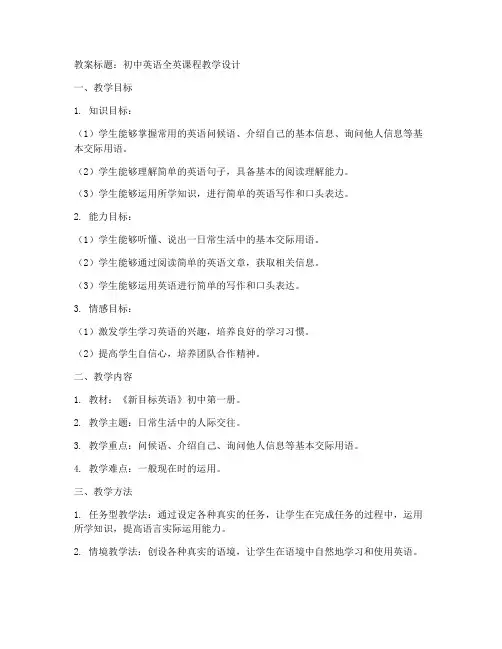
教案标题:初中英语全英课程教学设计一、教学目标1. 知识目标:(1)学生能够掌握常用的英语问候语、介绍自己的基本信息、询问他人信息等基本交际用语。
(2)学生能够理解简单的英语句子,具备基本的阅读理解能力。
(3)学生能够运用所学知识,进行简单的英语写作和口头表达。
2. 能力目标:(1)学生能够听懂、说出一日常生活中的基本交际用语。
(2)学生能够通过阅读简单的英语文章,获取相关信息。
(3)学生能够运用英语进行简单的写作和口头表达。
3. 情感目标:(1)激发学生学习英语的兴趣,培养良好的学习习惯。
(2)提高学生自信心,培养团队合作精神。
二、教学内容1. 教材:《新目标英语》初中第一册。
2. 教学主题:日常生活中的人际交往。
3. 教学重点:问候语、介绍自己、询问他人信息等基本交际用语。
4. 教学难点:一般现在时的运用。
三、教学方法1. 任务型教学法:通过设定各种真实的任务,让学生在完成任务的过程中,运用所学知识,提高语言实际运用能力。
2. 情境教学法:创设各种真实的语境,让学生在语境中自然地学习和使用英语。
3. 分组合作学习:将学生分成小组,进行合作学习,培养学生的团队合作精神和沟通能力。
四、教学步骤1. 热身活动(5分钟):教师与学生用中文进行简单的问候,然后引导学生用英语进行问候。
引导学生谈论自己的姓名、年龄、年级等基本信息。
2. 课堂导入(10分钟):教师用英语讲解本节课的主题,然后用中文解释,让学生明白本节课要学习的内容。
3. 新课教学(20分钟):教师用英语讲解一般现在时的用法,并用中文解释。
让学生通过观察、模仿、实践等方式,掌握一般现在时的构成和用法。
4. 练习与巩固(15分钟):教师设置各种练习题,让学生运用一般现在时进行回答。
同时,教师可引导学生进行分组练习,相互提问,巩固所学知识。
5. 课堂总结(5分钟):教师用中文总结本节课所讲内容,让学生明确自己所学知识。
6. 课后作业(课后自主完成):让学生运用一般现在时,写一篇关于自己家庭成员的短文。
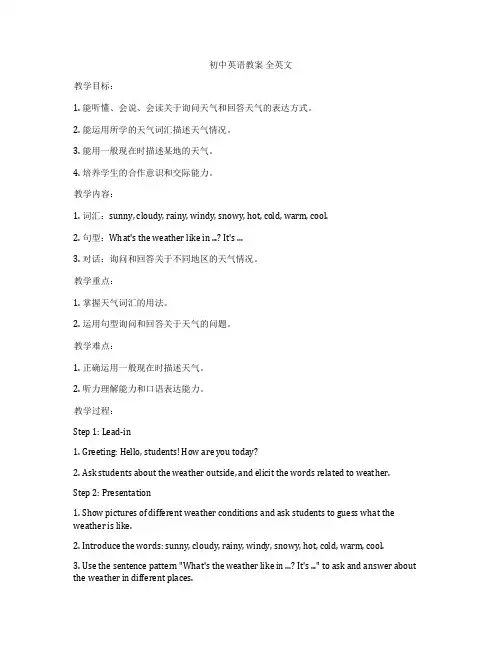
初中英语教案全英文教学目标:1. 能听懂、会说、会读关于询问天气和回答天气的表达方式。
2. 能运用所学的天气词汇描述天气情况。
3. 能用一般现在时描述某地的天气。
4. 培养学生的合作意识和交际能力。
教学内容:1. 词汇:sunny, cloudy, rainy, windy, snowy, hot, cold, warm, cool.2. 句型:What's the weather like in ...? It's ...3. 对话:询问和回答关于不同地区的天气情况。
教学重点:1. 掌握天气词汇的用法。
2. 运用句型询问和回答关于天气的问题。
教学难点:1. 正确运用一般现在时描述天气。
2. 听力理解能力和口语表达能力。
教学过程:Step 1: Lead-in1. Greeting: Hello, students! How are you today?2. Ask students about the weather outside, and elicit the words related to weather.Step 2: Presentation1. Show pictures of different weather conditions and ask students to guess what the weather is like.2. Introduce the words: sunny, cloudy, rainy, windy, snowy, hot, cold, warm, cool.3. Use the sentence pattern "What's the weather like in ...? It's ..." to ask and answer about the weather in different places.Step 3: Practice1. Ask students to work in pairs and practice asking and answering about the weather using the sentence pattern.2. Role-play the dialogue about asking and answering about the weather.Step 4: Consolidation1. Divide students into groups of four, and ask each group to create a weather report for a city using the words and sentence pattern they have learned.2. Choose some groups to present their weather reports in front of the class.Step 5: Summary1. Ask students to summarize what they have learned in this lesson.2. Teacher gives feedback and encourages students to use the language they have learned in real life.Step 6: Homework1. Write a paragraph about the weather in their hometown using the words and sentence pattern they have learned.2. Practice asking and answering about the weather with their family or friends. Blackboard Design:What's the weather like in ...?It's ...sunny cloudy rainy windy snowyhot cold warm coolNote: This is a 45-minute lesson plan for the first class of Unit 3 Topic 1 in a junior high school English course. The teacher should adjust the lesson plan according to the actual teaching situation and the needs of the students.。
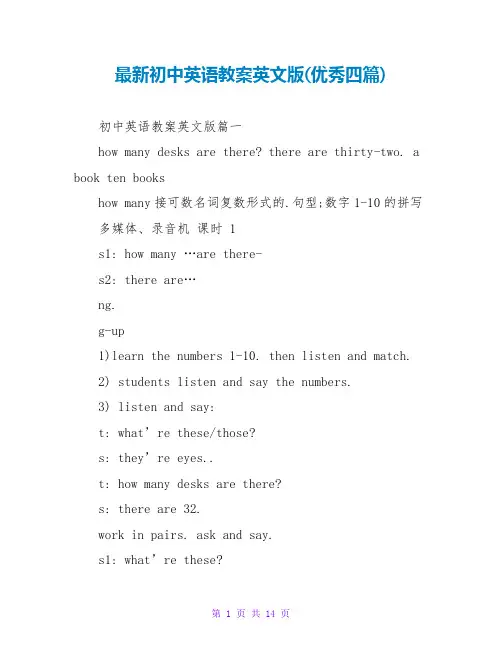
最新初中英语教案英文版(优秀四篇)初中英语教案英文版篇一how many desks are there? there are thirty-two. a book ten bookshow many接可数名词复数形式的.句型;数字1-10的拼写多媒体、录音机课时 1s1: how many …are there-s2: there are…ng.g-up1)learn the numbers 1-10. then listen and match.2) students listen and say the numbers.3) listen and say:t: what’re these/those?s: they’re eyes..t: how many desks are there?s: there are 32.work in pairs. ask and say.s1: what’re these?1) write the numbers.2) look at the pictures and write the phrases.derkwork book.个人修改初中英语教案英文版篇二starter module3 unit1 课型 listeningandspeaking学习询问颜色句型what colour are …? they are red. how do you spell “red”? r-e-d.颜色词汇的拼写记忆多媒体、录音机课时 1ng.g-up1)look and learn theword:apple,banana,flower,tree,bird,cat2) look at the pictures and the colour words.3) listen and say:t: what colour are they?t: how do you spell “red”?s: r-e-d..work in pairs. ask and say.s1: what colour are they?s2: they’re….s1: how do you spell it?s2: …se1) read and match.2) look at the pictures and write the sentences.derkwork book.初中英语教案英文版篇三sectiona 1a-2d一、教学目的〔一〕知识与技能:1. 学习并掌握1a-2d的单词和短语(1) rainstorm, alarm, begin ,heavily ,suddenly, strange;(2)go off, pick up, take a shower, make sure;2. 掌握并运用句型(1)what were you doing yesterday at the time of the rainstorm?(2)when you called, i was having a shower.(3)so while you were sleeping, i called jenny and she helped me.(4)what were you doing when the rainstorm came?3.掌握过去进展时态的构造和功能,学会使用when和while从句。
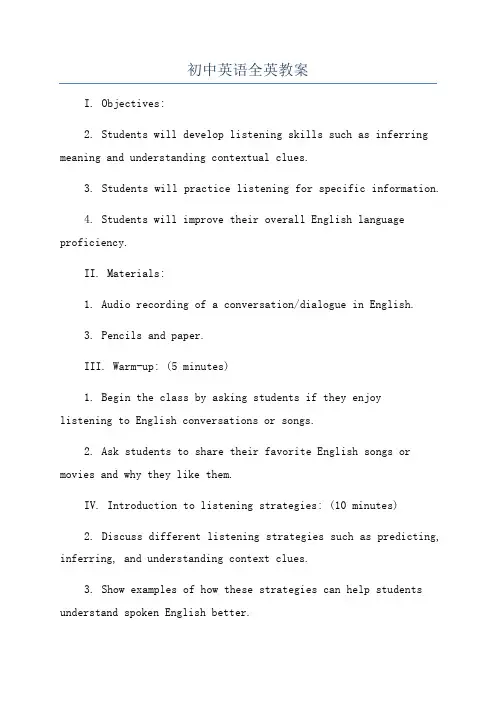
初中英语全英教案I. Objectives:2. Students will develop listening skills such as inferring meaning and understanding contextual clues.3. Students will practice listening for specific information.4. Students will improve their overall English language proficiency.II. Materials:1. Audio recording of a conversation/dialogue in English.3. Pencils and paper.III. Warm-up: (5 minutes)1. Begin the class by asking students if they enjoylistening to English conversations or songs.2. Ask students to share their favorite English songs or movies and why they like them.IV. Introduction to listening strategies: (10 minutes)2. Discuss different listening strategies such as predicting, inferring, and understanding context clues.3. Show examples of how these strategies can help students understand spoken English better.V. Pre-listening activity: (10 minutes)1. Introduce the topic of the audio recording to the students (e.g., going shopping, ordering food at a restaurant, etc.).2. Display pictures related to the topic and ask students to make predictions about what they might hear in the recording.VI. Listening activity: (15 minutes)1. Play the audio recording for the students.2. Ask students to listen carefully and try to understand as much as possible.3. Repeat the recording if necessary.VII. Post-listening activity: (15 minutes)3. Allow students to work individually or in pairs.VIII. Group discussion: (10 minutes)2. Encourage students to share their own ideas and interpretations of the audio recording.3. Ask students if they encountered any challenges while listening and how they overcame them.IX. Extension activity: (15 minutes)1. Divide the class into small groups.2. Provide each group with a different audio recording or dialogue.X. Conclusion: (5 minutes)1. Summarize what the students have learned about listening strategies and their importance.2. Encourage students to practice their listening skills outside of the classroom through activities like watching English movies or listening to English podcasts.XI. Homework assignment:1. Assign listening exercises from the textbook or provide links to online listening resources.2. Ask students to write a short reflection on their experience with the listening activity in class.。
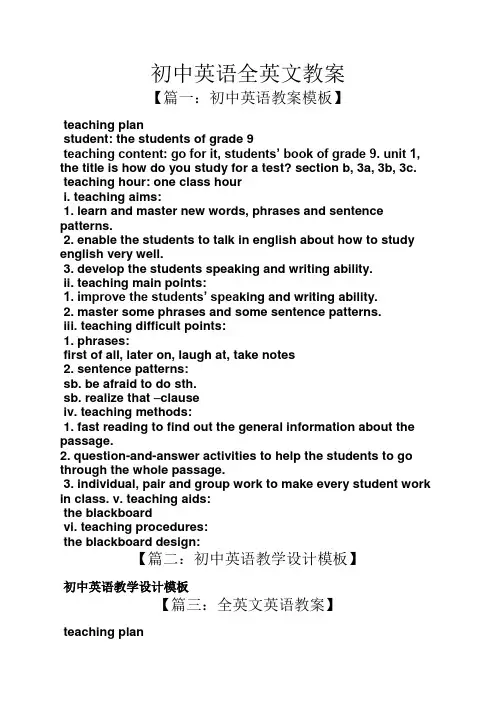
初中英语全英文教案【篇一:初中英语教案模板】teaching planstudent: the students of grade 9teaching content: go for it, students’ book of grade 9. unit 1, the title is how do you study for a test? section b, 3a, 3b, 3c.teaching hour: one class houri. teaching aims:1. learn and master new words, phrases and sentence patterns.2. enable the students to talk in english about how to study english very well.3. develop the students speaking and writing ability.ii. teaching main points:1. improve the students’ spea king and writing ability.2. master some phrases and some sentence patterns.iii. teaching difficult points:1. phrases:first of all, later on, laugh at, take notes2. sentence patterns:sb. be afraid to do sth.sb. realize that –clauseiv. teaching methods:1. fast reading to find out the general information about the passage.2. question-and-answer activities to help the students to go through the whole passage.3. individual, pair and group work to make every student work in class. v. teaching aids:the blackboardvi. teaching procedures:the blackboard design:【篇二:初中英语教学设计模板】初中英语教学设计模板【篇三:全英文英语教案】teaching plan姓名学号班级科目:指导老师lesson 3 living abroadⅠ.background information:1. student: 45 senior high school students, grade 22. class duration: 45 minsⅡ.teaching aims:by the end of the lesson, students will be able to1. use the new words and phrases to express themselves;2. know the functions of present participle and make sentences with the grammar;3. find some cultural differences between chinese and american.Ⅲ.teaching contents:1. vocabulary and phrases that help to express culturaldifferences, such as embarrassed, embarrassing, exchange, host, hospitable, appetite, modest, stare at, have a difficult time doing sth. insist / keep on doing sth. notice / hear / see sb. doing sth.2. functions of present participle:⑴ hear sb. doing sth. (object complement)⑵ an embarrassing experience (attribute)⑶ what he did is amazing. (predicate)⑷ i went back to the room closing the door. (adverbial)3. some cultural differences between chinese and american in three different situations.Ⅳ.teaching aids: ppt, pictures, paper.Ⅴ.teaching procedures:step 1. lead- int: good morning, everyone!ss: good morning, teacher!t: today we will learn lesson 3 living abroad. first, let us look at two pictures. (present the pictures.) the american mouse and the chinese mouse reply differently when they are praised, one in a confident way while the other in a modest way. so we will find some other cultural differences between american and chinese through the lesson.step 2. learn the new words and phrasest: before the text, let us learn the new words. oh, the first two words are embarrassing. do not worry! now, we only need to recognize them. “embarrassed” means feeling shy and stupid, and we say sb. feel embarrassed. “embarrassing” refers to making sb. feel shy and stupid, and we say sth. is embarrassing. the subject is different, and you can compare them with “interested” and “interesting”. understand?ss: yes!t: ok! next, the word “change” means “交换”, while “exchange” refers to“交换或交流”. for example, “cultural exchange” means — (ask students to translate it.)ss: 文化交流.t: yes! then, when foreign friends come to china, we chinese, as the host or hostess, should be hospitable. (point at the ppt and say “friendly and generous”.) appetite---when the host or hostess is hospitable, the guest may feel delighted and have a good appetite (point at the ppt and say “desire for food”.) now, the last two words. (point at the ppt.) most chinese are modest. (point at the ppt and say “talking little about one’s own ability and achievement) “stare at” means looking at for a long time without moving. read after me —“embarrassed”.ss: embarrassed.(read after me: embarrassing, exchange, host, hospitable, appetite, modest, stare at)t: do you know how to use the new words in phrases? let us learn them together. (next ppt.) no strange words in the phrases, so we start directly. xxx, the meaning of the first one, please.student a: 度过一段困难时期t: yes, sit down please. this phrase is similar to “have difficulty doing sth.” xxx, the second one, please.student b: 有一次尴尬经历t: ri ght! sit down, please. “look embarrassed” means “看起来尴尬”. and what about the fourth one?ss: 胃口好,有食欲.t: good! then, both “insist on” and “keep on” mean “继续”. the last one! “notice / hear / see + sb. + doing sth.” means “注意到/听到/看到+某人+正在做某事”. (show the sen tences.) xxx, could you translate the sentences into chinese for us? student c: 我听见她正在唱歌和我听到过她唱歌。
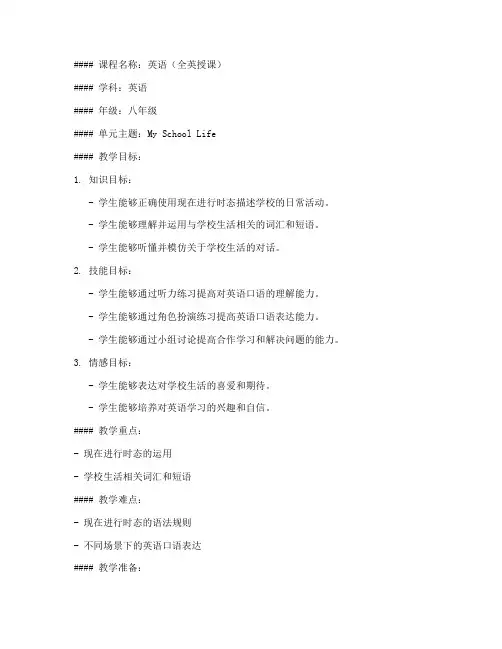
#### 课程名称:英语(全英授课)#### 学科:英语#### 年级:八年级#### 单元主题:My School Life#### 教学目标:1. 知识目标:- 学生能够正确使用现在进行时态描述学校的日常活动。
- 学生能够理解并运用与学校生活相关的词汇和短语。
- 学生能够听懂并模仿关于学校生活的对话。
2. 技能目标:- 学生能够通过听力练习提高对英语口语的理解能力。
- 学生能够通过角色扮演练习提高英语口语表达能力。
- 学生能够通过小组讨论提高合作学习和解决问题的能力。
3. 情感目标:- 学生能够表达对学校生活的喜爱和期待。
- 学生能够培养对英语学习的兴趣和自信。
#### 教学重点:- 现在进行时态的运用- 学校生活相关词汇和短语#### 教学难点:- 现在进行时态的语法规则- 不同场景下的英语口语表达#### 教学准备:- 教学课件- 多媒体设备- 学校图片或视频资料- 互动游戏材料#### 教学过程:一、热身活动 (Warm-up)- 时间:10分钟- 活动:播放一首与学校生活相关的英文歌曲,让学生跟随歌曲唱出歌词。
二、导入 (Introduction)- 时间:5分钟- 活动:教师展示学校图片或视频,引导学生用英语描述图片内容,引出学校生活的主题。
三、新课导入 (New Lesson Introduction)- 时间:15分钟- 活动:1. 教师讲解现在进行时态的构成和用法。
2. 学生跟随教师练习现在进行时的句子构造。
3. 教师展示与学校生活相关的词汇和短语,如“study in the library”、“play sports in the playground”等。
四、听力练习 (Listening Practice)- 时间:15分钟- 活动:1. 播放一段关于学校生活的英语对话,让学生听取并回答问题。
2. 学生复述听到的对话内容,教师进行纠正和补充。
五、口语练习 (Speaking Practice)- 时间:20分钟- 活动:1. 学生分组,每组选择一个学校场景进行角色扮演。
完整版初中英语全英教案教学目标:1. 学生能够了解和掌握与节日相关的词汇和表达方式。
2. 学生能够通过听力、口语、阅读和写作等多种方式运用所学知识。
3. 学生能够了解和比较中西方节日的差异,提高跨文化交际意识。
4. 学生能够通过小组合作,培养团队合作精神和语言运用能力。
教学内容:1. 相关节日词汇:New Year's Day, Spring Festival, Easter, Halloween, Christmas等。
2. 节日相关表达:庆祝,传统,习俗,礼物,装饰等。
3. 中西方节日比较:春节与New Year's Day,元宵节与Lantern Festival,清明节与Tomb-Sweeping Day等。
教学步骤:Step 1:Lead-in(5分钟)1. 教师通过提问方式引导学生谈论他们所知道的节日,激发学生兴趣。
2. 学生分享各自的节日经历,教师给予鼓励和反馈。
Step 2:Listening Practice(10分钟)1. 教师播放一段关于节日的听力材料,学生听后回答相关问题。
2. 学生分组进行听力练习,教师巡回指导。
Step 3:Vocabulary Learning(10分钟)1. 教师展示节日词汇卡片,学生跟读并模仿。
2. 学生通过小组合作,用所学的节日词汇造句,教师给予评价。
Step 4:Reading Comprehension(10分钟)1. 教师分发阅读材料,学生阅读后回答问题。
2. 学生进行小组讨论,分享阅读心得,教师给予指导。
Step 5:Oral Practice(5分钟)1. 教师创设节日场景,学生进行角色扮演,运用所学词汇和表达进行口语交流。
2. 学生互相评价,教师给予鼓励和建议。
Step 6:Writing Assignment(10分钟)1. 教师布置写作任务,要求学生写一篇关于他们最喜欢的节日的短文。
2. 学生进行写作,教师巡回指导并提供帮助。
初中英语全英文教案教案标题:初中英语全英文教案教学目标:1. 学生能够理解和使用一些常见的英语词汇和表达方式。
2. 学生能够运用所学的语法知识构建简单的英语句子。
3. 学生能够通过听、说、读、写的综合训练提高英语综合应用能力。
4. 学生能够培养积极的学习态度和团队合作意识。
教学重点:1. 学习和掌握基础的英语词汇和句型。
2. 培养学生的听、说、读、写的综合应用能力。
3. 培养学生的自主学习和团队合作意识。
教学难点:1. 学生在初学阶段可能面临语言障碍,需要逐步培养英语学习兴趣和自信心。
2. 学生需要逐步习惯使用英语进行交流和表达。
教学准备:1. 教师准备PPT、录音设备等教学工具。
2. 学生准备课本、笔记本等学习用具。
教学过程:Step 1: Warm-up (热身活动)1. Greetings and self-introduction (问候和自我介绍)- 教师用英语向学生问候并自我介绍,鼓励学生用英语回答问候并进行自我介绍。
2. Vocabulary review (复习词汇)- 教师通过图片、实物等方式复习上一节课所学的英语词汇,鼓励学生用英语描述这些物品。
Step 2: Presentation (呈现)1. Introduce new vocabulary (介绍新词汇)- 教师通过图片、视频等方式向学生介绍新的英语词汇,并帮助学生理解和记忆这些词汇。
2. Introduce new sentence structures (介绍新句型)- 教师通过示范和练习,引导学生学习和掌握新的英语句型,并帮助学生理解句型的用法和意义。
Step 3: Practice (练习)1. Pair work (小组活动)- 学生分成小组进行对话练习,使用所学的词汇和句型进行交流和表达。
2. Role-play (角色扮演)- 学生分角色进行对话练习,模拟真实情境,提高口语表达能力。
Step 4: Production (输出)1. Group discussion (小组讨论)- 学生分组讨论指定的话题,运用所学的词汇和句型进行讨论,并展示自己的观点和意见。
初中英语全英教案一、前言1. 教学目标:通过本课程的学习,使学生能够听、说、读、写全面发展,掌握基本的英语语法和词汇,提高学生的英语交际能力。
2. 适用年级:七年级3. 教学方法:采用任务型教学法、情境教学法和分组合作学习法,激发学生的学习兴趣,提高学生的参与度。
二、Unit 1 Greetings and Introductions1. 教学目标:学生能够用英语进行基本的问候和自我介绍。
2. 教学内容:a. 日常问候语:Hello, Good morning, Good afternoon, Good evening, How are you?b. 介绍自己:My name is, I am from, I am 13 years old.c. 询问他人:How old are you? Where are you from?3. 教学活动:a. 引导学生进行角色扮演,模拟真实场景进行问候和自我介绍。
b. 组织学生进行小组活动,用英语介绍自己的朋友。
三、Unit 2 Family and Friends1. 教学目标:学生能够用英语描述自己的家庭成员和朋友。
2. 教学内容:a. 家庭成员词汇:father, mother, brother, sister, grandparent, cousinb. 朋友词汇:friend, classmate, neighbor, teacherc. 介绍家庭成员和朋友:This is my, She/He is my3. 教学活动:a. 让学生带照片来学校,用英语介绍自己的家庭成员和朋友。
b. 组织学生进行小组活动,用英语讨论彼此的家庭和朋友。
四、Unit 3 School Life1. 教学目标:学生能够用英语描述自己的学校生活。
2. 教学内容:a. 学校场所词汇:classroom, library, playground, cafeteriab. 学校活动词汇:study, read, write, play, exercisec. 描述学校生活:I go to school , My favorite subject is3. 教学活动:a. 让学生绘制自己的学校生活时间表,并用英语进行介绍。
初中英语教案全英文版初中英语教案全英文版(精选篇1)教学目标1.会使用可数名词和不可数名词开购物单。
为后两课学习购物做准备。
2. 学会讨论吃什么饭,买什么东西。
3.复习一些礼貌用语和习惯表达,如:How about…? What about…? Can you come with me? What do you have for dinner this evening? Let me and havea look.等。
4.新单词:chicken, tofu, fridge, list, shopping list, buy, kilo句型:What do we have for dinner this evening?Fish is my favourite.What else do you want to have?Don’t we have any eggs?Let me make a shopping list.You can help me carry the things.教学用具PPT教学演示课件教学步骤Step 1 Revision[课件展示]教师在课堂上提问题,引导学生回答 What do you have for breakfast today? Shall we go and buy something to eat? What’s in the pictures? Let me see. What do we have for lunch today? How about…? What about…? What else do you want to have? Can you go and buy the things? Let’s go.等。
老师也可以同样的方式提问全班同学。
教师展示课件中Revision的食物图片,复习一些食品的名称。
Step 2 Presentation[课件展示]教师在复习食品名称基础上,引出购物的话题。
初中全英英语教案Teaching objectives:1. Knowledge objectives:- Students can understand and use the key words and sentence patterns about animals. - Students can read and understand the dialogue about animals.- Students can write a short passage about their favorite animal.2. Ability objectives:- Students can communicate with peers about animals in daily life.- Students can improve their listening, speaking, reading, and writing skills.- Students can work collaboratively and critically think about animal protection. Teaching key and difficult points:1. Key points:- Students can master the key words and sentence patterns about animals.- Students can understand the dialogue and use it in real-life situations.- Students can write a passage about their favorite animal.2. Difficult points:- Students can use the key words and sentence patterns correctly in sentences.- Students can think critically about animal protection and express their opinions. Teaching methods:1. Task-based learning: Students will engage in various tasks related to animals, such as reading, writing, and discussing.2. Collaborative learning: Students will work in groups to complete tasks and share their ideas.3. Critical thinking: Students will analyze and discuss the topic of animal protection. Teaching procedures:Step 1: Lead-in (5 minutes)- The teacher will show pictures of different animals and ask students to name them.- Students will have a brief discussion about their favorite animals.Step 2: Presentation (10 minutes)- The teacher will introduce the key words and sentence patterns related to animals.- Students will practice using the key words and sentence patterns in sentences.Step 3: Practice (15 minutes)- Students will read the dialogue about animals and answer some questions.- Students will practice the dialogue in pairs or groups.Step 4: Application (10 minutes)- Students will write a short passage about their favorite animal, using the key words and sentence patterns they have learned.- The teacher will provide guidance and support as needed.Step 5: consolidation (10 minutes)- Students will work in groups to discuss the topic of animal protection.- Each group will present their ideas and opinions on animal protection.Step 6: Summary (5 minutes)- The teacher will summarize the main points of the lesson and emphasize the importance of animal protection.Blackboard design:Unit 4 Topic 1: AnimalsKey words:- Monkey, panda, tiger, elephant, lion, giraffe- I like, because, interesting, friendly, cleverSentence pattern:- I like (animal). Because (reason).This lesson is designed to help students learn about animals, their characteristics, and the importance of protecting them. Through various tasks and activities, students will develop their listening, speaking, reading, and writing skills. Additionally, students will learn to think critically about animal protection and express their opinions on the topic.。
初中英语教案模板全英文Student: The students of GradeTeaching Content: Go for it, students’ book of grade. Unit 1, the title is How do you study for a test? Section B,a,b,c.Teaching hour: One class hourTeaching plan:I. Teaching Aims:1. Learn and master new words, phrases and sentence patterns.2. Enable the students to talk in English about how to study English very well.3. Develop the students speaking and writing ability.II. Teaching Main Points:1. Improve the students’ speaking and writing ability.2. Master some phrases and some sentence patterns. III. Teaching Difficult Points:1. Phrases:first of all, later on, laugh at, take notes2. Sentence Patterns:Sb. be afraid to do sth.Sb. realize that –clauseIV. Teaching Methods:1. Fast reading to find out the general information about the passage.2. Question-and-answer activities to help the students to go through the whole passage.3. Individual, pair and group work to make every student work in class. V. Teaching Aids:The blackboardVI. Teaching Procedures:The Blackboard Design:人人教育一对一个性化辅导教案初一上重要语法:一.Where’s my schoolbag?询问某人或某物的位置,意思是·······在哪里。
Be Careful with Numbers inListening Class: Class 12, SeniorTwoDate: May16,2007 Teacher:Ni YazhenSchool: Zhi Yuan Senior High SchoolTeaching Material: P75 S2B Oxford English;Additional material(The new Star Wars movie, Be Careful withNumbers)Teaching Objectives: Knowledge objectives:To enable students to listen and complete some exercisesAbility Objectives:To encourage the students to have basic skills of listening.Emotion objectives:To cultivate the cooperation through peer interactionTeaching aids:Multi-mediaTeaching and learning method:Guiding for learningTeaching Procedures:I. PresentationToday we’ll have a class on listening practice “Be careful with numbers in listening”:First we’ll play a game. Then, we’ll practice.Lead-inA game onnumber II. Performance:Quick and accurate response to numbers is very important in daily communication.Telephone numbers, addresses, prices, temperatures, time and dates all closely linkedwith the use ofnumbers .Besides, numbers also play a very important part in broadcastprogrammes such as reportsNow let’s listen to some advice from experts.Task 1Be Careful with Numbers (Play the recorder Twice) Individual work→pairwork(check the answer with your partner)→Groupwork(Underline the important sentences. e.g.Th e differences between million and billion, “-teen’s” and“-ty’s” are …..“Seventeen point five million.”…)Whole class read the key sentences. Well-done!Numbers are all around us.Let us practice with numbers and learn to be good atnumbers.(First read out the following numbers… Watch the screen)Task 2Listen to some statements about the brief history of films andTV.First check the answers in groups. If you have different opinion ,please raise your hands.Judgement: (First students give themselves ajudge.Then teacher does it)It seems no challenge. Now, We’ll dochallenge exercise. So pay special attention to thenumbers in the passageand select the correct answer from the choices listed below.First teach thestudents new words in listening material. Then ask students to read outthe numbers in Star Wars.III. Promotion: Challenge exerciseStar WarsListen to the tape twice →Checkthe answersIV. Conclusion: What we learned today is “Be careful with numbers in numbers.”Remember the following points when you are doing listening tasks:1.Take great care with the spelling of names and with addresses and phones numbers,prices, time and dates...2. To find the right answer, you may need to do simple calculations or combine two setsof data.3. Listen carefully for words and ph rases such as these:half / twice as expensive as…it’s shorter / cheaper / quickerthan… the lightest / heaviest / newestnot as long / cheap / good as…Some useful abbreviations and symbols for note taking( See PPt.)V. Assignment:1.Review P6-7 –Filling in forms P43– Working with numbers2.Collect some information on listening skillsTeaching PlanBe Careful with Numbers in ListeningClass: Class 12, Senior TwoDate: May16,2007 Teacher:Ni YazhenSchool: Zhi Yuan Senior High SchoolTeaching Material: P75 S2B OxfordEnglish;Additional material(The new StarWars movie, Be Careful withNumbers)Teaching Objectives: Knowledgeobjectives:To enable students to listen and complete some exercisesAbility Objectives:To encourage the students to have basic skills of listening.Emotion objectives:To cultivate the cooperation through peer interactionTeaching aids:Multi-media3dTeaching and learning method:Guiding for learningTeaching Procedures:4dI. PresentationToday we’ll have a class on listening practice “Be careful with numbers in listening”:First we’ll play a game. Then, we’ll practice.Lead-inA game onnumber II. Performance:Quick and accurate response to numbers is very important in daily communication.Telephone numbers, addresses, prices, temperatures, time and dates all closely linkedwith the use of numbers .Besides, numbers also play a very important part in broadcastprogrammes such as reportsNow let’s listen to some advice from experts.Task 1Be Careful with Numbers (Play the recorder Twice)Individual work→pairwork(check the answer with your partner)→Groupwork(Underline the important sentences. e.g.The differences between million and billion, “-teen’s” and“-ty’s” are …..“Seventeen point five million.”…)Whole class read the key sentences. Well-done!Numbers are all around us.Let us practice with numbers and learn to be good atnumbers.(First read out the following numbers… Watch the screen)Task 2Listen to some statements about the brief history of films andTV.First check the answers in groups. If you have different opinion ,please raise your hands.Judgement: (First students give themselves ajudge.Then teacher does it)It seems no challenge. Now, We’ll dochallenge exercise. So pay special attention to thenumbers in the passageand select the correct answer from the choices listed below.First teach thestudents new words in listening material. Then ask students to read outthe numbers in Star Wars.III. Promotion: Challenge exerciseStar WarsListen to the tape twice →Checkthe answersIV. Conclusion: What we learned t oday is “Be careful with numbers in numbers.”Remember the following points when you are doing listening tasks:4. Take great care with the spelling of names and with addresses and phones numbers,prices, time and dates...5. To find the right answer, you may need to do simple calculations or combine two setsof data.6. Listen carefully for words and phrases such as these:half / twice as expensive as…it’s shorter / cheaper / quickerthan… the lightest / heaviest / newestnot as long / cheap / good as…Some useful abbreviations and symbols for note taking( See PPt.)V. Assignment:1.Review P6-7 –Filling in forms P43– Working with numbers3.Collect some information on listening skills5dTeaching Plan----Yang XuefenContent: Unit 4 He said I was hardworking.<<Go For It>>, Grade8(Ⅱ) Time: March 12th, the 1st period,Place: Class 6, Grade 8Teaching goals:7. Knowledge goal:4. Vocabulary: hard-working, be mad at, not---anymore5. Patterns: What did Marcia say?She said she was she was having a party for Lanna.22. Ability goal:Learn to report what someone said correctly33. Moral goal:To teach students not to report wrong message or they may cause trouble.To be an honest and good kid, report what someone said correctly.Teaching aids: multi-mediaTeaching procedures:Step 1: Leading in by free talking with the students: Ask several Ss what they aregoingto do after school .Write their sentences on the Bb. How are you?How is yourmother?What are you doing?What is your mother doing?What do you do in the morning?What about your mother?What are you going to do after school?What is your mother going to do after work?I’m fine.My mother is fine.I’m having a class.My mother is working.6dI have lessons in the morning?My mother works in the morning.I am going to play sports after school My mother is going to cook after work.Step 2: Pre-task7dT: Now I’m going to report what xx said to you: xx said he was fine. And he said his mother was fine, too. He said he was having a class and his mother was working. He saidhe had lessons in the morning and his mother worked in the morning. He saidhe was going to play sports after school. He said his mother was going to cook after work. Step 3: While-task8. Observe the sentences on the blackboard, find out what is different in my report He/ She said--------.6. SBp26/1a: Write the words soap opera on the board. Point to the picture and ask students what they think a soap opera is.Point out the TV screens in the picture. Ask one student to read what the person says in the first picture .Then ask another student: What did she/he say? Help to answer: She/He said she/he was having a surprise party for Lana on Friday night.23. Repeat with the other pictures.SB Page 26 , 1b . Listen and Number thepictures. SB Page 27 , 2a & 2b .34. Ask some individuals to read thesesentences. 2. Play the recording .Ss circle theiranswer.3. Check theanswers. Step 5:Grammar Focus1. Review the grammar box. Ask Ss to say the statements.2. Explain: In each case, the direct speech talks about present situations and the reported speech talks about past situations .Step 6: Practice:1.Pass on What MsYang said one to another, then the last one tell the whole class: I love my students.Ms Yang said she loved her students.I can speak English.Ms. Yang said she could speak English.I want to be a writer.Ms. Yang said she wanted to be a writer.I am playing games with my students.Ms. Yang said she was playing games with her students.2.What can you do?What are you going to be when you grow up?How are you going to do that?----------8dReport: xxx said he/she could---.He/She was going to be a/an----.She/ He was going to----Xxx said ------I hope -----Step 7:HomeworkGrammar FocusSection A9dStep1 Lead-in9. Ask students: What year is this year?10. Show students the picture of twelve animals in Chinese horoscope, and tell themdifferent namesTell them this year is in the year of the Rat.11. Ask students:How old are you? When were you born? (What year were you born in?)What is your animal sign?What characters do you think it has?12. Ask students: What month were you born in? (review twelve months in a year)13. Tell students that everyone in western countries has his or her own star sign.(T: We know that animal signs are very popular in Chinese culture, we are familiar withthem. But people in western countries have their own star signs according to the birthmonth. It can tell you something about your abilities, talents and special qualities.)Step 2 Welcome to the unit7. Show students the picture of star signs. “How much do you know about them?”Letstudents guess different star signs. (can be in Chinese)8. In the West, people use some creatures to represent the star signs. Can you tell me theirnames? Teach students new words.9. Look at the pictures and read the new words after the teacher.10. Let students finish Part A on P7 and check the answers by reading the names.11. Some more exercises to see if students have known the star signs.(1) Show students 6 pictures and name the star signs.(2) Play a guessing game: fill in the blanks by using the names of the creatures.12. Tell students there are 6 more star signs and let them guess what they are representedby using the 6 pictures in Part B on P7.13. Check the answers toPart B. Step 3 Oral practice24. Ask students: When is your birthday? What is your star sign?10d25. Show students the twelve star signs and let them point out their own star sign in bothEnglish and Chinese. Ask the students to try to remember their own star sign.26. Pair work: Let students ask and answer in pairs.Step 4 Comic strips14.Are you interested in star signs? So are Eddie and Hobo. Listen to their conversationand repeat it after the tape.15. Ask students some questions to see if they have known the dialogue.(1) Who brings Eddie the newspaper?(2) What does Hobo ask Eddie to read? Why?(3) What do Eddie’s stars say?(4) What happens to Eddie’s breakfast at the end of the story?16. Let students read the dialogue by themselves (or practice in pairs)17. Do some more exercises after reading and check the answers together.18. What do you think Hobo’s and Eddie’s star signs are?19. Oral practice:Try to act out this dialogue in pairsAsk the students to make a new dialogue by adding their own ideas.Step 5 Homework14. Remember the star signs.15. Make up a new dialogue about star signs.16. Try to find out how many classmates are under the star sign as you.Step 1 Revision27. Finish some exercises.20.Review the star signs: look at the star signs and name them. Read together after theteacher.21. Guessing game: (Test who has the best memory) Teacher will say the Chinese name ofthe star sign; students try to find out the right picture and say the name in English.Step 2 Lead-in17. Free talk:(1) What is your star sign?(2) Can you tell me something about yourself? ( abilities, special qualities,characteristics)(3) How many students are under the same star sign as you? (Yest erday’shomework)(4) What are they like? (clever, kind, generous, hard-working, brave, patient, polite….)(5) Do you share similar characteristics?(Let students speak out as many adjectives about characters as possible.)18. Do you know these words? They are also used to describe people. (Teach the newwords, and finish Exercise B on P10.)19. Read the new words after the teacher. Then let students read the sentences bythemselves.20. Do some more exercises to see if students have known all the words’meanings.Step 3 R eading28. T: It’s said that star signs can represent a person’s characteristics. Let’s check if it istrue. Please listen to the tape and learn something about them.29. Reading task 1: After listening to the tape, do “T” or “F”questions.30. Reading task 2: Ask students some questions to check if they have known the mainidea, with the books open.(1) Is Aries lazy?(2) Which star sign likes savingmoney? (3) Does Sagittarius like tellingjokes?(4) Which star sign has the best imagination?(5) If your birthday is on 13th September, what is your star sign?31. Make students read the article passage by passage and try to find out the adjectives todescribe people’s characteristics with the picture of each star sign. (Esp. their own starsign)T: Whose star sign isAries? When is yourbirthday?What characteristics do you have/ do this star sign have?Aries: energetic, active, impatient, selfishTaurus: stubborn, hard-working, patientGemini: curious, clever, outgoingCancer: kindLeo: strong, confident,generousVirgo: modest,practical Libra: polite, fair,elegant Scorpio: powerful, silly Sagittarius: humorous, luckyCapricorn: successful, patientAquarius: kind, wise, strangePisces: generous, kind, gentle, easy-going, creative, imaginative22. Discussion:What is your star sign?Do you have the same characteristics as the star sign says?Do you think what the star signs say about people are facts?-- So we can have a conclusion: What the star signs say about people are not facts. Wecan just learn about star signs for fun.Step 4 Some More Exercises21. What are your characteristics?Write a short description of your own characteristics.22. Then show your description to your partner.23. Discuss with your partner whether or not you agree with each other.Step 5 Homework32. Read the passage three times.33. Remember all the adjectives which describe a person’s characteristics.Step 1 Revision35. Ask students some questions while showing Picture 1.(1) How many star signs are there in a year?(2) How do you know your star sign? What decides your star sign?(3) Do the people under the same star sign share similar characteristics?(4) What characteristics do the people under your star sign have?36. Explain the language points while answering the above questions.1) A year is divided into 12 different star signs.2) Your date of birth decides your star sign.3) People born under the same star sign share similar characteristics.23. Ask more questions about Reading1) Which star sign doesn’t give up easily?2) Which star sign loves peace and doesn’t like to argue with others?3) Which star sign is suggested to forgive others for their mistakes?4) Which star sign likes to dream about everything?24. Teach the language points by answering the above questions.(1) You are patient and do not give up easily.(2) You love peace and do not like to argue with others.(3) Sometimes it is silly of you not to forgive others for their mistakes.(4) You like to dream about everything.Step2 Group work24. Show students some pictures and passages about some famous people. Let studentsguess what star signs they are?25. Finish Part C2 on Page11, and then check the answers.26. Discussion:What kind of friend do you like to make?(Why?)What is his/her star sign?(Let students talk about his or her own characteristics and his or her friend’s.)27. What star signs are suitable for these jobs? Why?Step 4 ConclusionWhat star signs say about people are not facts.We should work hard to make our dream cometrue.Step 5 HomeworkRead the passage again and again.2. Do some exercises. 精品文档word文档可以编辑!谢谢下载!34.。